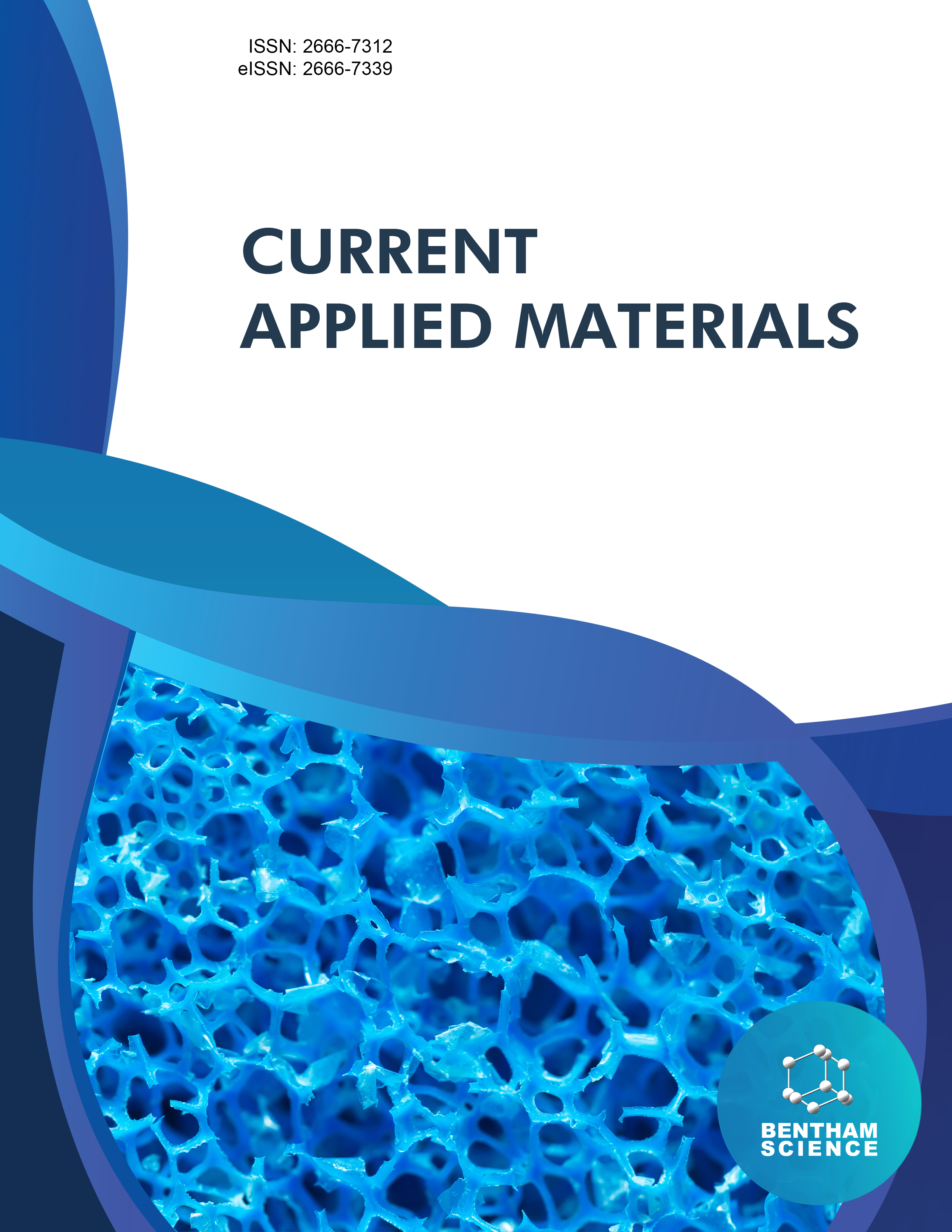- Home
- A-Z Publications
- Current Applied Materials
- Previous Issues
- Volume 1, Issue 1, 2022
Current Applied Materials - Volume 1, Issue 1, 2022
Volume 1, Issue 1, 2022
-
-
Carbon Nanotubes Based Composites for Electromagnetic Absorption - A Review
More LessAuthors: Navdeep Singh and Gagan Deep AulRadar is a delicate detection device and since its evolution different techniques for reducing electromagnetic reflections have been discovered. This paper provides a concise review on fundamentals of absorption which reduce radar cross section from stealth target with which radar cross section affects the survivability and mission capability. The reduction of radar cross section depends on dielectric and magnetic properties of the Read More
-
-
-
2D and Layered Ti-based Materials for Supercapacitors and Rechargeable Batteries: Synthesis, Properties, and Applications
More LessAuthors: Wei Ni and Lingying ShiTitanium-based two-dimensional (2D) and layered compounds with open and stable crystal structures have attracted increasing attention for energy storage and conversion purposes, e.g., rechargeable alkali-ion batteries and hybrid capacitors, due to their superior rate capability derived from the intercalation-type or pseudocapacitive kinetics. Various strategies, including structure design, conductivity enhancement, surfa Read More
-
-
-
Pure PZT95/5 Ceramics and Its Phase Transition Behavior Under External Fields
More LessAuthors: Hengchang Nie, Fei Cao, Genshui Wang and Xianlin DongBackground: Compositionally modified Pb(Zr0.95Ti0.05)O3 (PZT 95/5) ferroelectric materials have been extensively investigated in past decades for many important applications. However, few study on pure PZT95/5 ceramics have been reported. Objective: Herein, pure PZT95/5 ceramics were successfully prepared, and their microstructure and phase transition behaviors under external fields were studied. Methods: The pure P Read More
-
-
-
Benzotriazacycle Cored Perylene Diimide Non-fullerene Acceptors for High-performance Organic Solar Cells
More LessAuthors: Min Deng, Zhenkai Ji, Xiaopeng Xu, Liyang Yu and Qiang PengBackground: Perylene Diimide (PDI) is among the most investigated non-fullerene electron acceptor for Organic Solar Cells (OSCs). Constructing PDI derivatives into three-dimensional propeller-like molecular structures is not only one of the viable routes to suppress the over aggregation tendency of the PDI chromophores but also rise possibilities to tune and optimize the optoelectronic property of the molecules. Objectiv Read More
-
-
-
Synthesis and Blue Emission Properties of Co-doped CdS Semiconductor Nanoparticles
More LessBackground: Cadmium Sulfide (CdS) based semiconductors are of great interest for different high-end applications because they pose a direct bandgap (2.42 eV). CdS are used as the main constituent material in many applications, namely solar cells, electroluminescent, and quantum dot light-emitting diodes. Transition metal-doped CdS revealed considerable influence in the bandgap, photoluminescence properties and pe Read More
-
-
-
Nanoformulation of Glycyrrhizic Acid as a Potent Antiviral Agent Against COVID-19
More LessAuthors: Sayani Ghosh and Prasun PatraIn many previous studies, liquorice plant (Glycyrrhiza glabra) extracts have been found to contain more than 300 natural compounds, most of which are triterpenoids and flavonoids, and show promising results in clinical studies for treating many microbial and viral infections. Triterpenoids, like glycyrrhizic acid, have shown anti-SARS-CoV activity in vitro. Experimentally, certain glycyrrhizic acid derivatives have shown increas Read More
-
-
-
Evaluation of Rare-earth Sesquioxides Nanoparticles as a Bottom-up Strategy Toward the Formation of Functional Structures
More LessBackground: The strategy to form functional structures based on powder technology relies on the concept of nanoparticles characteristics. Rare-earth sesquioxides (RE2O3; RE as Y, Tm, Eu) exhibit remarkable properties, and their fields of application include energy, astronomy, environmental, medical, information technology, industry, and materials science. The purpose of this paper is to evaluate the characteri Read More
-
-
-
Green Synthesis of Deep Ultraviolet Response Nanophosphors with Tunable Full-visible-spectra Emission for Luminescent Temperature Sensing
More LessAuthors: Yiran Jiao, Jun Liu, Fen Wang, Yuan Pu, Fuhong Cai and Dan WangBackground: Recently, the CaMoO4 nanocrystal has been viewed as one of the most promising substrates for rare-earth-doped nanophosphors due to its high density, stable chemical properties, and good Deep-Ultraviolet (DUV) responding characteristics. Aim: In this work, a green synthesis approach is proposed to obtain rare-earth-doped CaMoO4 nanodispersion with full-visible-spectra emission by using an ethanol-water mi Read More
-
-
-
Role of Cotton as Nesting Material in Female Mice as a Behavioral Indicator for Pup’s Health
More LessAuthors: Rajnish Srivastava and Mansi RastogiBackground: Nesting is an essential neuropsychological motor behavior that helps conserve heat for reproduction and shelter building to protect offspring from environmental change. Aim: The aim of the present study was to investigate how putting cotton in the cage influenced the nesting behavior of female mice. Objective: The objective of the present work is to validate and establish the role of cotton as nesting material. Read More
-
Volumes & issues
Most Read This Month
Article
content/journals/cam
Journal
10
5
false
en


